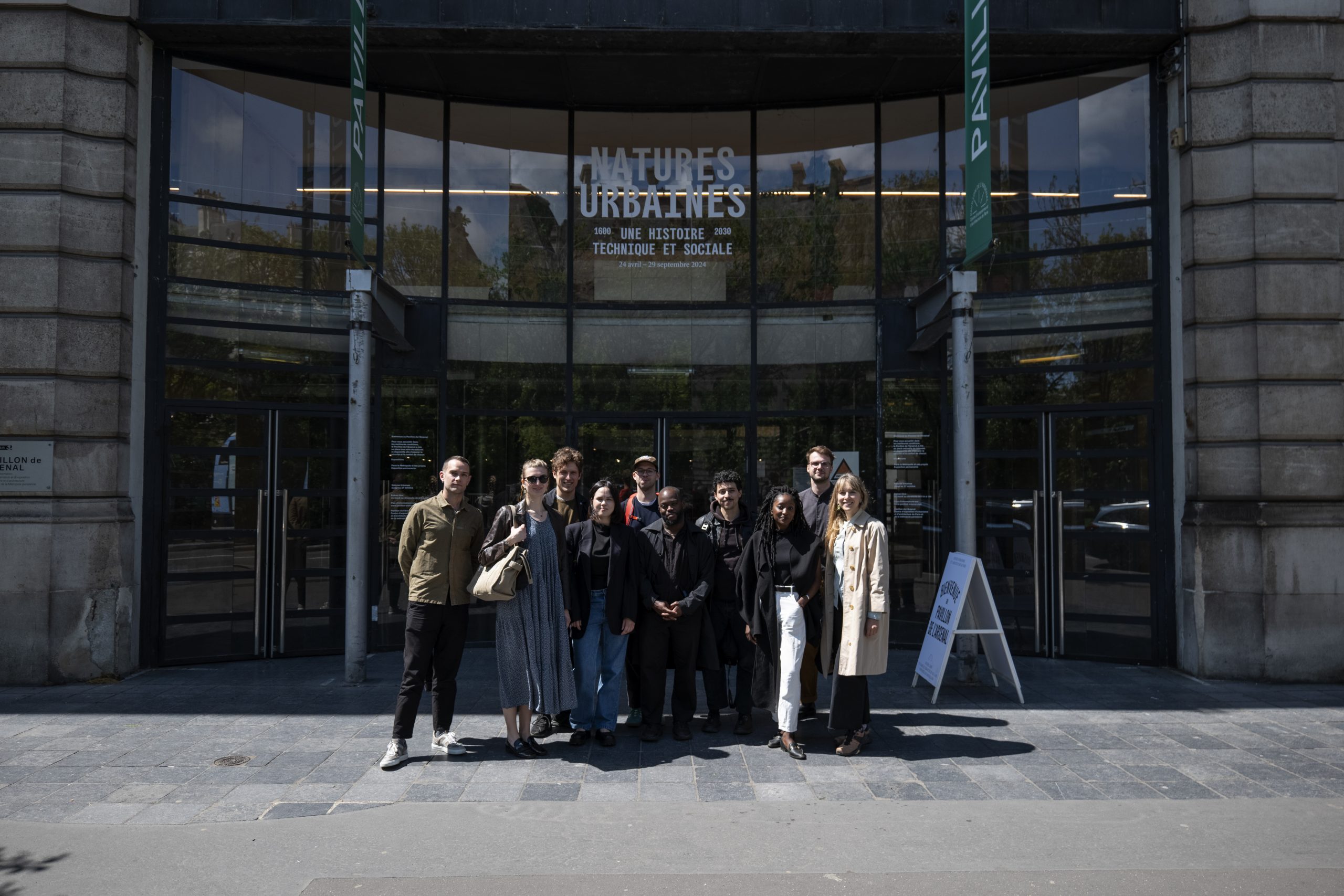
As a sprout springs through ground, the solid surface folds like drapery – notes on the friction points and urban oases of a growing Paris
We started exploring Paris with an excursion outside the city. After the radical transformations carried out in the mid-nineteenth century according to the plan of G.E. Haussmann1, Paris has grown considerably from the city limits envisaged by the urban planner. Today, the metropolitan area known as the Greater Paris includes many individual communes–towns which, while still administratively autonomous, have become part of a single organism, the Greater Paris.
One of these communes – Saint-Denis, located in the north of Paris, will be the epicentre of the Olympic Games this summer. The Stade de France, built for the 1998 FIFA World Cup, was recently renovated to make it fit for the Olympics, as is much of the city’s existing sports infrastructure. Overall, the Games are striving to make the city stand out in terms of sustainability as part of the Climate Change Agreement2, so most of the infrastructure needed for the event is being renovated, with only a few new facilities being built.
On Monday afternoon, chatting with the residency participants, we left Saint-Denis and headed towards Aubervilliers, another city-commune swallowed by the metropolis. A heavy May downpour unexpectedly washed our plans away, and we took shelter in one of the arches of the 70s Brutalist settlement. We stayed longer than planned in this urban oasis reminiscent of London’s Alexandra Road, so we had plenty of time to chat and observe this unique place. La Maladrerie is an urban residence designed by Renée Gailhoustet, one of the few architects of the time who had the opportunity to lead major urban projects and who also managed to achieve significant international recognition for her exceptional work.

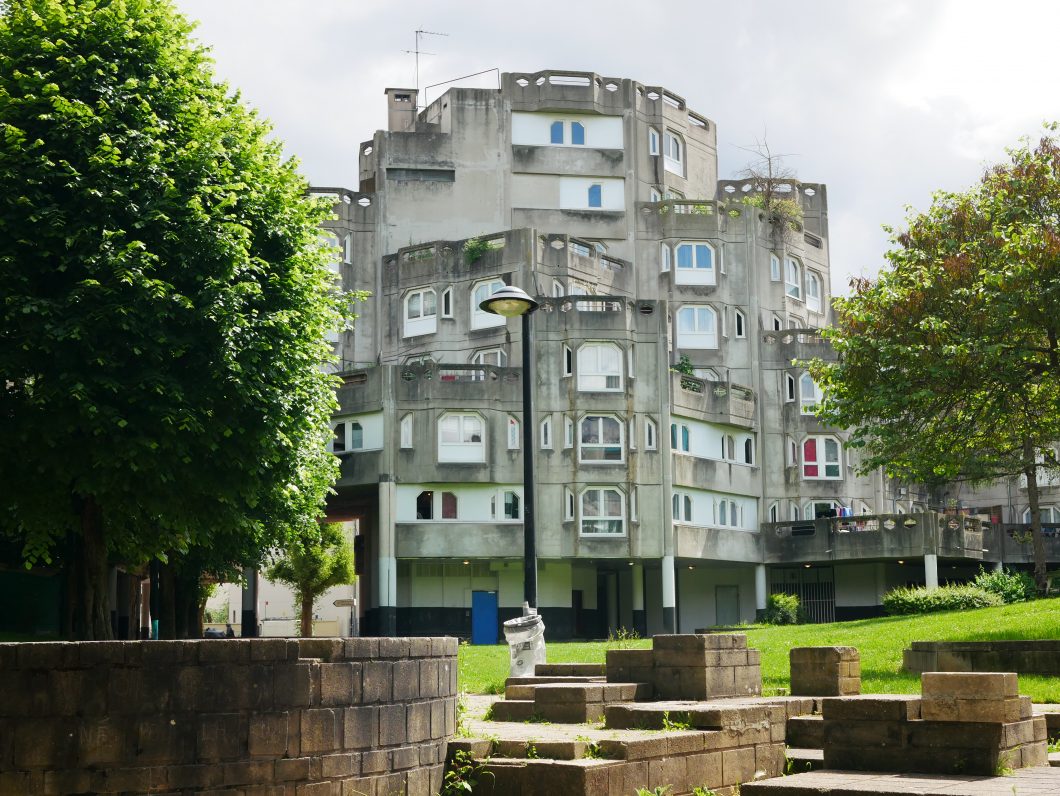
La Maladrerie, realised during the dominance of standardised mass architecture, offered Parisians an alternative vision of urban living. Unlike most urban projects with a brutalist spirit, here we didn’t feel the architects’ desire to overwhelm with sculptural grandeur. The iconic sharp-edged buildings indeed catch the eye from a distance, and as you get closer, the cosy winding paths and bromides invite you to discover the settlement. They create a pulsating set of public spaces as if you’re strolling in a forest. The playful concrete forms of the complex melt sensitively amidst the abundant vegetation, and it’s difficult to grasp the exact volumes of the buildings, as most of them are divided by landscaped terraces with an innovative solution for the time – a 30 cm thick earth base that allowed trees to be grown on the roofs.
When the rain stopped, we got off from our temporary shelter and finished our tour at the nearby metro stop located next to the swimming pool named after Camille Muffat, which was recently built after the demolition of the Aubervilliers Community Gardens. Behind the festive Olympic façade here lies a different attitude of the city’s citizens towards the Games, which, according to some Parisians, have turned into a bold argument for the government authorities to make more radical changes in the city, which are far from universally cherished.
We continued our exploration of Paris transformations on Tuesday, this time in the city centre. located in the so-called third space3 Les Arches Citoyennes, we met to discuss the participants’ work at the Theatrum Mundi studio. The complex of buildings with its cosy courtyard is a former headquarters of the city hospital, now temporarily functioning as a place of residence and study for various creative and social organisations. There are many temporary urbanism experiments in the city, but this one reveals the strong political stance to regulate housing policy aiming to ensure the diversity of society, even in the central parts of the city. In the future based on plans created by the team lead by the architect Dominique Perrault, the building will be redesigned as social housing for social care workers. New architectural interventions (lifts, additional balconies, terraces) are intended to keep the original structure so that the building can easily be returned to its original use.
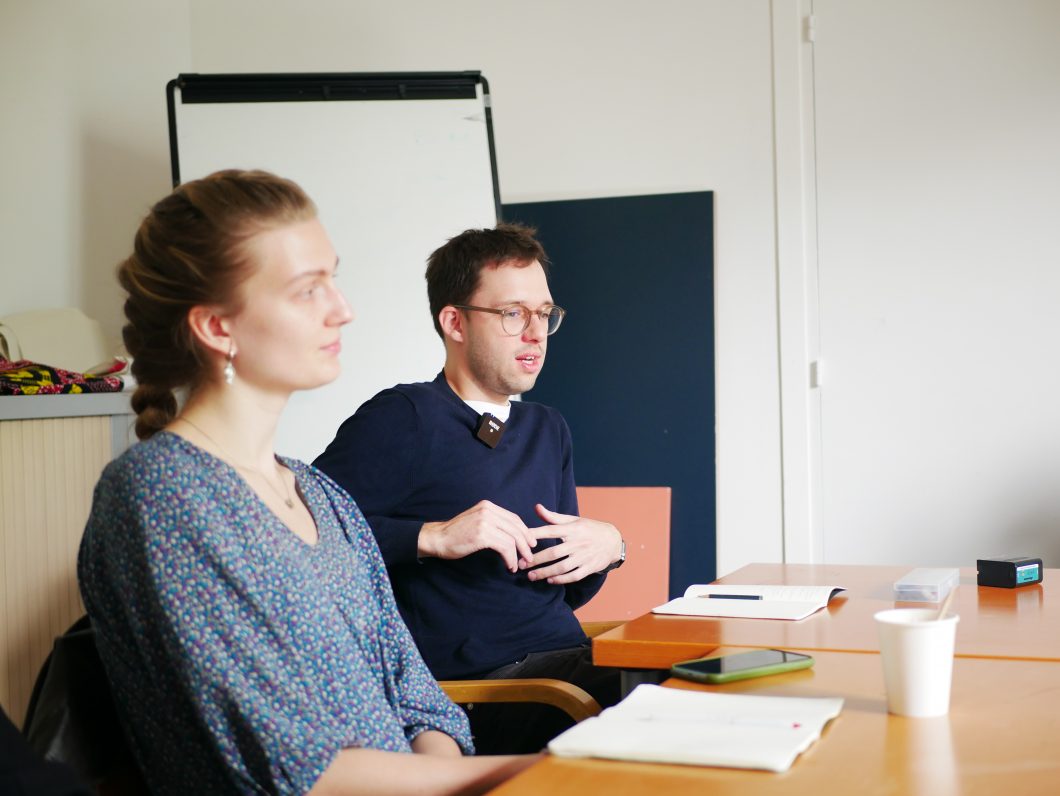
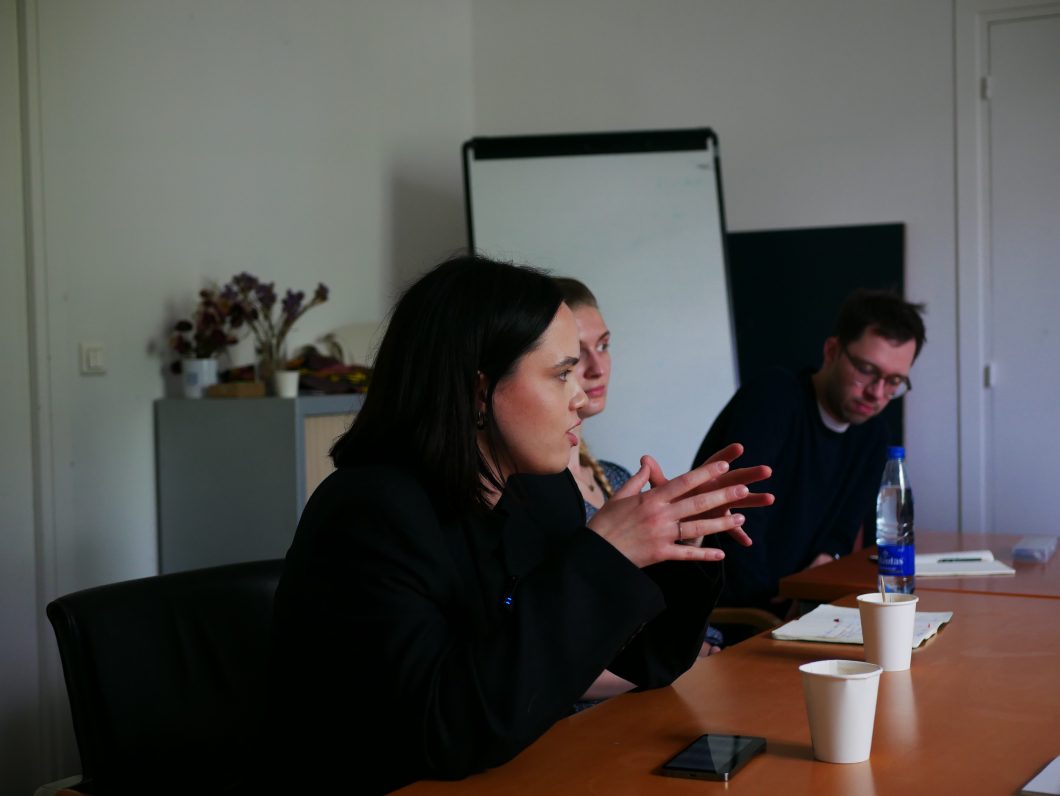
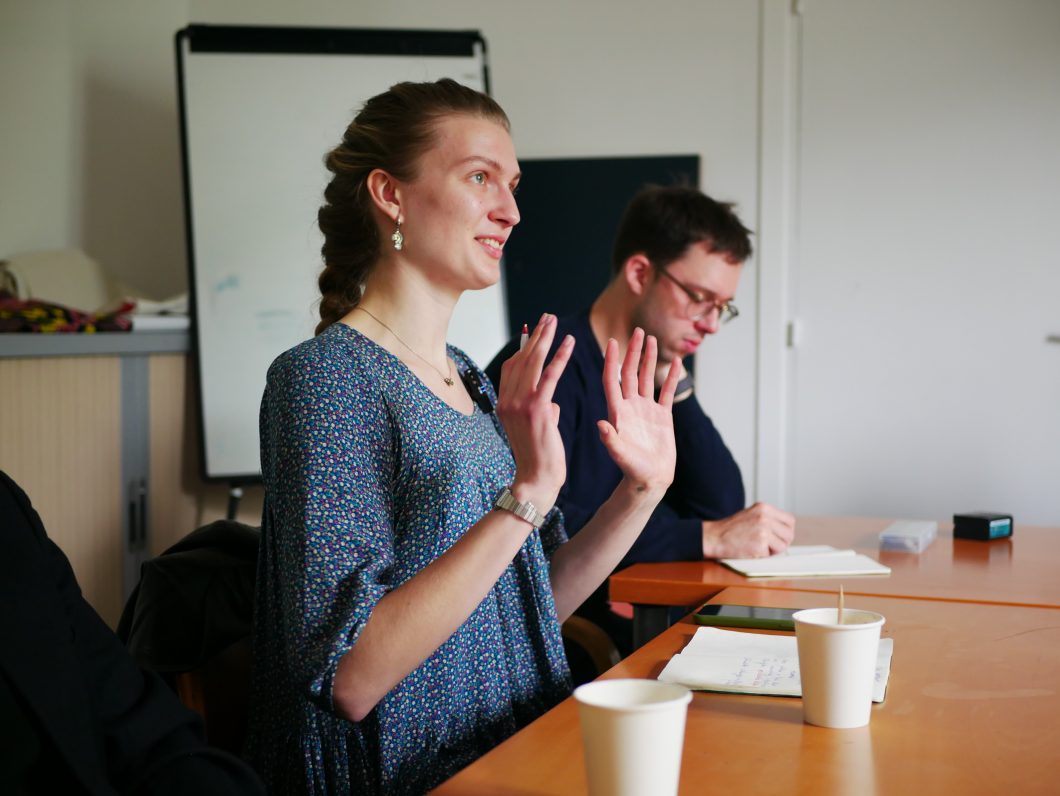
After discussing the relevance of Experiments’ Platform participants’ research with the mentors Océane Ragoucy, Ewa Effiom and Margarida Waco, we headed towards the architectural centre Pavillon de l’Arsenal for the ‘Urban Natures’ exhibition, presenting the evolution of the planning of the cities’ natural elements over the last 300 years. The plans for the city’s parks and other green and blue infrastructures reflect a broader ideological shift in the relationship with nature, from the Enlightenment and Romanticism to postmodernism and a contemporary mindset imbued with an understanding of the Anthropocene.
Marta Dorotėja Lekavičiūtė, one of the Experiments’ Platform participants, also takes a fresh look at the relationship between the city and the natural environment. By examining the plants of the rivers Neris in Vilnius and Seine in Paris and their possible use in architecture, Marta Dorotėja Lekavičiūtė delves deeper into the characteristics of the hydro-flora and confronts the urban processes that affect the rivers. In Paris, the water treatment infrastructure of the Seine is currently the centre of attention, which enabled only the opening of the Olympics but also was aimed at making the swimming triathlon possible here. It seems that soon Parisians will be able to enjoy the Seine in the same way that Vilnius residents enjoy the Neris in summer.
We also met Pavillon de l’Arsenal director Marion Waller, formerly Chief Adviser to the Chief Architect of Paris. Marion gave a rather concise but substantial summary of today’s urban challenges and the impact the Centre has on the city. Interestingly, the Pavillon de l’Arsenal not only seeks to develop a discourse on sustainability through exhibitions, publications and other public events but also aims to contribute to the creation of relevant urban change through research-based solutions. For example, actively engaging in drawing up the conditions for public competitions obliges future developers or administrators to take into account social and ecological aspects in architecture.
In the afternoon we returned to Les Arches Citoyennes for a lecture on the never-ending street-automobile highway – Boulevard Periphérique or just periph– by the urban planner and researcher Magda Maaoui (Atelier Parisien d’Urbanisme/Harvard University). Built in the second half of the 20th century as a link between emerging suburban areas, this 35 km ring road became the new urban border of Paris, marking the administrative boundary and the social exclusion of the city. The towns outside the periph are not officially part of the city of Paris, but the inhabitants of this unité urbaine, mostly migrants from former French colonies, are a strong economic force in the city of Paris: if the periph encircles Paris, the most densely populated area in Europe with about 2 million inhabitants, the outer periphery is home to another 8 million people.
These outskirts began to grow significantly in the post-war years when the circling bypass was built as a link between the different suburban areas. The highway soon became a hostage to its own devices – a place of constant traffic congestion. As soon as they were confronted with the newly created problems, the immediate suggestion of urban planners at the time was a second traffic ring for Paris. Over time, urban planning has become more complex and hasty solutions have been avoided, but the issue of peripheral mobility has only become more pressing since then. However, the future fate of this modernist urban ring is being addressed at the metro construction sites on the periphery of the metropolitan area.
All of us have personally experienced that the public transport system in Paris is still quite centralised. It’s impossible to get from Saint-Ouen to Aubervilliers in the near vicinity without going to the centre of Paris for the fastest route, and often the journey from the far periphery to the centre of Paris can take even longer than the train journey from Brussels. To address these mobility challenges, a new metro project linking the metropolitan region – the Grand Paris Express – has been underway for ten years. In the afternoon, we had the opportunity to visit one of its construction sites located near the city’s first airport, Le Bourget, which was recently turned into an aerospace museum.

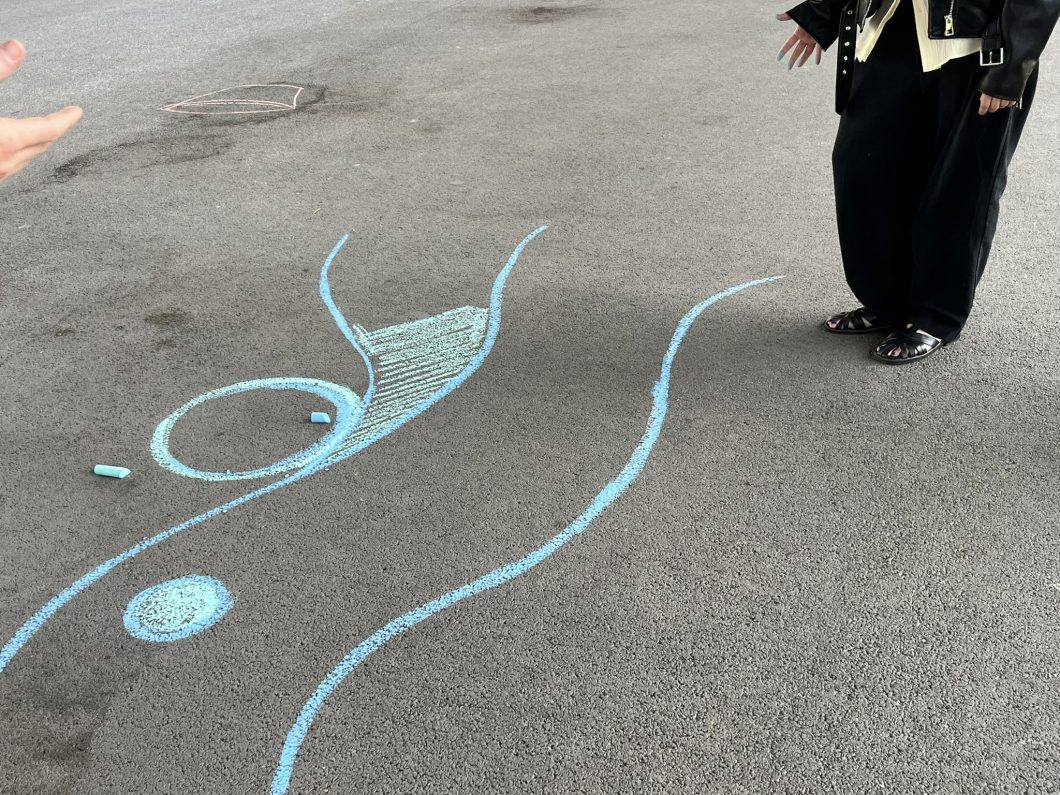
Over ten years in the making, the construction of this Metro system is one of the largest infrastructure projects under development in the world. Paris is once again experiencing a megalomaniacal urban development project in the spirit of Haussmann and is openly proud of it. The project includes the construction of 4 new automatic metro lines, 68 new metro stations and many more infrastructure developments to support the system. But it’s not just about connecting the metropolitan region in terms of mobility – the Grand Paris Express is one of the pretexts for changing and extending the city’s outdated administrative boundaries. With these changes in mind, it seems Paris’ snail4 is set to at least double in size in the near future, and the suburban areas are about to undergo significant underground as well as onground urban changes.
After a day full of stories about the colossal transformations of the city, on Wednesday the Experiments’ Platform participants returned to more palpable scales. In the Chapelle Charbon park in the north of Paris, near the periphery, we met architect and dancer Dimitri Szuter, who shared his experimental practice of developing public spaces, which was also in the focus during the creation of this particular park. Inspired by the work of dancer Anna and landscape architect Lawrence Halprin couple, Dimitri continues to develop the RSVP cycles5 (acronym: Resources, Score, Valuation, Performance) methodology. This creative strategy combines choreographic and design practices and can be applied in a wide range of ways, from creating a performance to designing a park or even organising a dinner party — the key is to remain open to change, as this approach is all about constantly responding to changing environments, actors and situations.
After a joint lunch with Dimitri’s recommendations, we set off in our own directions. Edgar Vladimirenko, a participant of the Experiments’ Platform working on the rural territories changes under the influence of different political visions, visited a former village-town in the north of Paris. The visit drew Edgar’s attention to the embodied significance of the experience of space. Here, the signs of an abandoned settlement contrasted with the sound of aeroplanes scratching the sky. The drama of metropolitan urbanisation is perhaps most striking against this backdrop of daily life surrounding — witnessing not only the growth and international connectivity but also to disappearance and loss of rurality.
The question of corporeality in the city was also relevant to my trajectories. I took the opportunity to visit the CENTQUATRE cultural space recommended by Dimitri. Built in the nineteenth century, the huge complex of buildings, which resembles a train station, was designed as a funeral service centre. After more than a hundred years of operation, the importance of this huge complex has diminished with the abolition of the monopoly on funeral services and the opening up of the market to the private sector. In 2008, it was converted into a cultural space for citizens. As soon as you enter, the spectacular, large, light-filled space is filled with the sounds of music and the abundance of moving bodies – during the day, it acts as an open platform for dancers, circus and other performative artists to practise independently. There are also temporary accommodations for migrants, social housing, residences and small business shops, and in the evenings there are various cultural events and even parties.
So is there no room for eternal rest in a growing city? On Thursday, Océane, a Parisian mentor of the Experiments’ Platform, invited us to explore this topic by visiting the Père Lachaise Cemetery. Paris’ most famous necropolis is also the most visited tourist site in the city. Thanks to Océane, we not only had the opportunity to visit the graves of Edith Piaf, Jim Morrison, Pierre Bourdieu and even the aforementioned Haussmann6, but also to hear more about Océane’s own research focusing on what she calls the invisible jobs and the people who carry them. Mainly these works are invisible to us as their primary aim is to keep the city running as we know it. However decay and death is inevitable and takes an important part of our collective lives as well as rituals and spaces of remembrance. Père Lachaise is symbolically the densest area of Paris not only in terms of cultural capital but also in terms of elementary per capita. The sensitive functioning of the area is therefore determined by a series of rules that specify not only the economic value of the place but also the daily processes and maintenance procedures. In the park-like old cemetery, Océane also invited us to pay attention to the abundant vegetation between the tombstones and pavement. The lushness is a consequence of the recent municipal maintenance policy change, which forbade chemically killing unplanned plants in public spaces. These seemingly minor changes in maintenance practice mean that the various herbaceous plants that spring through the pavement not only bring a more savage atmosphere of the city landscape but also contribute to a mitigation of the microclimate in the city carved out of the limestone7.
In the afternoon, we headed back to the busier part of the city, crossing the periphery and arriving at the commune of Aubervilliers, where we met the members of the Umarell collective – Johanna Musch and Robert Louis. They told us about the big real estate development plans for this area. Acting as independent researchers, Johanna and Robert are being critical to the project, but are actively looking for alternative strategies to take action in needed urban transformation. The Artagon art and Social Centre, currently located on the site of a former secondary school, is another example of temporary urbanism, but the fate of the site is still less defined. Therefore, by contributing to subtle spatial interventions, the Umarell collective is trying to create a vision of the site that first of all responds to the needs of the neighbouring citizens.
And the need for public space in this part of the city is certainly problematic. Johanna and Robert drew our attention to the groups of men who hang out on the streets, seemingly doing nothing. The true reason for this is that many of them don’t have any adequate living spaces or proper air-cooling in their homes, and some of them don’t have steady jobs. Given these social and spatial challenges, it’s hard to grasp in what precarious situation are women and children, who are living in an area, but are visible on the streets. This is why Umarell projects for Aubervilliers mainly focus on vulnerable social groups. Here in the neighbourhoods on the outskirts of the periph, we have sensed social tensions, where the need for public spaces and accessible services is a serious political challenge.
Our afternoon charged with social discussions ended by returning to the city along the Canal de l’Ourcq to la Villette Park. Although it now functions as an open urban park–cultural space, la Villette used to be an industrial area. In the 1980s, an international architecture competition was organised to convert the former site of the slaughterhouses and a national meat market. The winning architect, Bernard Tschumi, proposed to spread the newly created cultural programme throughout the park in architectural pavilions – follies8. Each of them is a deconstructed assemblage of architectural elements from the former building complex of the site, painted bright red. The symbolic reuse playfully tells the multifaceted story of this territory change.
Today, in the middle of the park, right next to the canal, new pavilions were built to house the sports federations for the Olympic Games. The Archi-follies were designed by students from 20 different architecture schools in France. Each design proposal of these temporary structures also paid close attention to the disassembly and afterlife of the materials Such examples were also the focus of the Experiments’ Platform participant Simona Gaigalaitė. For an architect exploring the potential of pavilions in the design of urban public spaces, the rich tradition of the Parisian landscaping tradition and contemporary tendencies were the perfect places for discovery. Simona shared that seeing these pavilions also inspired her to explore the possibilities of the architectural medium itself to convey stories.
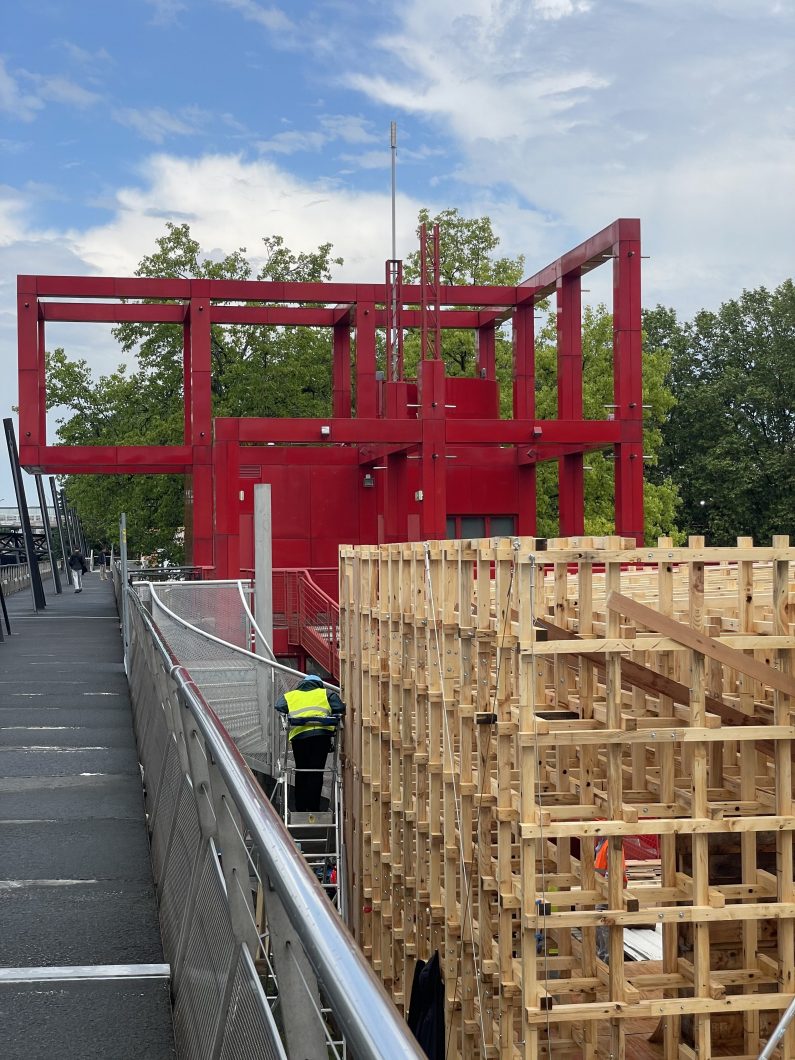


The week was full of visits and personal discoveries which we shared during the last meeting of the residency. We felt that even in such a short time we had a chance to grasp the challenges of this growing city, full of contradictions and spontaneity, the friction points charged by the transformation processes, and took refuge in an urban oasis where life flourishes with diversity. On the 14th of November, we will return to Paris for the final Experiments’ Exchange event, which will take place at Césure, a third space located in the former premises of the Sorbonne University campus. During the event, we will not only present the works of the Experiments’ Platform participants but also invite professionals working in the contexts of Paris and Vilnius for a joint discussion about the ecological and social challenges of contemporary urban areas.
Author of the text: Martynas Germanavičius.
As a joint collaboration between Architektūros fondas and Theatrum Mundi the creative residency of Experiments’ Platform is a part of the European programme LINA and also part of this Lithuanian season in France.
- In the mid-19th century, G.E. Haussmann was responsible for the urban planning and implementation of the transformation of the city of Paris as we know it today. Not only was the city expanded and compacted, but in the process many of the old inhabitants of the city were evicted. ↩︎
- The United Nations Framework Convention on Climate Change (UNFCCC) Climate Change Agreement, signed in Paris in 2015 by the vast majority of the world's countries, aims to keep global warming below safe levels. ↩︎
- The Third Space (Tiers-lieu) is a term coined by sociologist Ray Oldenburg to refer to spaces of socialisation that are not meant for living (the first space) or working (the second). Interestingly, this scientific term is popular among the French, even in the colloquial language. In Lithuania, however, it is common practice to divide spaces into public and private, thus emphasising the ownership aspect. Most third spaces would not fall under this strict distinction between public and private, as they are often overseen by non-governmental organisations or cooperative structures between private and public sector organisations.
↩︎ - After Haussmann's reconstruction, Paris was administratively divided into 20 municipal districts (fr. arrondissements) in a spiral principle. ↩︎
- The essence of this method is to experience, create and perform scores with your body.
↩︎ - Ironically, G.E. Haussmann himself wanted to destroy the cemetery by moving it out of the city. ↩︎
- During the expansion of Paris, much of the limestone and gypsum used to build buildings and pave streets was mined in underground mines over which the city itself later grew. In the 19th century some of the tunnels were used to build another great underground necropolis - Paris Catacombs. However till this day the perforated underground situation limits the height of buildings. Interestingly, during the construction of the Grand Paris Express metro network, some of the excavated earth is used to fill in these mines.
↩︎ - Folly is a term used by English and French landscape architects for extravagant building-like decorative structures, often imitating historic buildings. ↩︎

